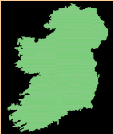![]() A wider variety of dances
A wider variety of dances
 Teachers from all classes in Dublin and as far south as Laois met or were represented at a meeting held over the holiday period where they agreed to broaden the base of dances at céilithe. At present, Ireland's capital city has up to thirty set dancing teachers with 35 classes or more, all of which work mainly in isolation.
Teachers from all classes in Dublin and as far south as Laois met or were represented at a meeting held over the holiday period where they agreed to broaden the base of dances at céilithe. At present, Ireland's capital city has up to thirty set dancing teachers with 35 classes or more, all of which work mainly in isolation.
The sets danced at these céilithe vary from the early Borlin set through to the modern day Borlin Jenny. In spite of all the classes, teachers and there is a core of only eight dances known to most of these dancers. In a fragmented world of classes this core will be the same in five years' time. If a céilí depends on dancers from outside the class of the caller, and by and large this is the case, it is impossible to call a new dance because so few people know it;
Unless the core is continually nourished and nurtured by adding some different dances, it will become dull and lifeless. It will lack colour and sparkle and will lose its 'oomph' and ability to enthuse;
Workshops and classes are suffering increasingly from a bug known as 'We will never dance this dance at a céilí';
On January 4th a very positive group of teachers established the principle of working together to expand the core of dances at our céilithe. For the first time ever a precedent of co-operation has been set. Six fairly well known dances, five sets and one céilí dance, were chosen. The aim is to teach these dances at our classes and then to dance them more often at our céilithe so that all dance enthusiasts will enjoy more variety and have a greater repertoire by June 1999. The group further agreed to circulate to their members a list containing dates of all céilithe in Dublin. During January and February the Labasheeda, West Kerry and Connemara Jig sets will be danced more frequently, while March and April will see the Eight-hand Jig as well as the Durrow Threshing and Clare Orange and Green sets at our céilithe. May and June will be used for consolidation of the 'revised core' which could include up to fourteen dances. What next? The group will meet again on September 6th to review the scheme. Your views on this project as well as ideas for the next step will be welcomed.
Dublin set dancing teachers met for the second time this year in a continued effort to broaden the base of dances included at ceilithe around the city. It was agreed that the concept of dancing a wider variety of dances was well received not only in Dublin but around the country and further afield with many favourable comments from some dance bands. The January report published in the February-March issue of Set Dancing News mentioned a core of eight dances which were known to most dancers. Put to the test most people were able to name them. For the record these eight were: the Caledonian, Plain, Connemara, Corofin, Mazurka, Castle and Newport Sets. Depending on the dancers on a particular evening at a particular venue the following dances were categorised as being well known: the Derradda, the Ballyvourney Jig as well as the Caidhp (the High Cauled Cap). At the meeting on September 6th last it was decided that the Labasheeda and West Kerry Sets
were relatively well known and were duly added to the core group of sets. The group decided to concentrate on the Connemara Jig, the Clare Orange and Green and the Durrow Threshing Sets as well as the Eight-Hand Jig. The following dances were added to the list for particular attention during the coming months: the Fermanagh Set, the Rosscahill Set and the South Sligo Lancers Set as well as the Sweets of May. Another meeting is planned for December. Your comments and views are very welcome.
![]()